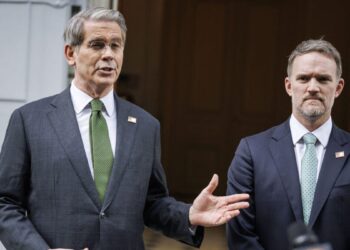Tesla CEO Elon Musk revealed on Thursday that the automaker started production on the Tesla Semi.
Musk announced two months ago that the electric big rig, which was unveiled in 2017 and originally scheduled to be produced in 2019, would begin production by the end of the year. The first completed vehicles will be delivered to Pepsi on December 1.
“From day one, having a Tesla Semi will beat a diesel truck on economics,” Musk said during a launch event five years ago.
The Tesla Semi can accelerate from a standstill to 60 miles per hour within 20 seconds while fully loaded, according to a webpage from Tesla. Charging the vehicle is considerably cheaper per mile, resulting in an estimated $200,000 in cost savings within the first three years, while fewer moving parts and over-the-air software updates reduce the need for repairs.
“Reliability is incredibly important. The truck is your life, it’s your business,” Musk continued. “If your truck breaks down, you’ve disappointed your customers. It could be a horrible day or a horrible week, it could break down in the middle of nowhere.”
Diesel trucks can travel 2,100 miles on a single tank, according to an analysis from logistics company Schneider, while Tesla’s electric version will have a range of 500 miles. During the launch event, however, Musk argued that drivers could recharge while taking their periodic breaks already required under the law.
The rollout of the Tesla Semi occurs as state and federal regulators create incentives for electric vehicle ownership. A recent set of draft guidelines from the California Air Resources Board would mandate that all medium-duty and heavy-duty trucks entering ports and railyards must be zero-emission by 2040, with state and local government fleets reaching the benchmark by 2027.
“A number of policies to reduce pollution from engines and their fuels have made significant progress, but more needs to be done, especially considering the long-life of trucks and the urgency of climate action,” the document argued.
Weeks earlier, the agency issued new rules requiring 35% of new electric cars to produce zero emissions by 2026 — a standard that will reach a 100% benchmark by 2035. Analysts have cautioned that the California electric grid, which faced blackouts during a heatwave last month, will require significant upgrades to manage a rapid transition away from internal combustion vehicles. Alerts from the state’s power authority prompted residents to refrain from charging their electric cars during peak demand hours.
The White House has set the “ambitious target” of ensuring that electric vehicles constitute 50% of car sales in the United States by 2030. President Joe Biden recently signed the Inflation Reduction Act, which includes $7,500 tax credits for new electric vehicles.
Transportation Secretary Pete Buttigieg argued during a keynote address at the recent Texas Tribune Festival that residents of the Lone Star State could save money by buying electric cars to bypass elevated prices at the pump. “Some of the best use cases for electric vehicles are in places like Texas,” Buttigieg said, “places where people spend more time in their vehicles, where you drive longer distances than in a dense coastal city and therefore spend more money on gas and therefore would save more money — provided you can afford an electric vehicle, which is why we’re fighting to make electric vehicles cheaper.”











